New performance goals in the offing

Beyond the overall review, DDM Beth Cobert says there is more to come on the administration's look at IT procurement and program management.

DDM Beth Cobert -- shown here testifying before the Senate Homeland Security and Governmental Affairs Committee in January -- says there is more to come on the administration's look at IT procurement and program management.
The Obama administration's performance goals will be refreshed as part of the fiscal 2015 budget plan, and the Performance.gov website where progress on goals is recorded will get a refresh, according to Beth Cobert, deputy director for management at the Office of Management and Budget.
The Obama administration sets goals for individual agencies and across agencies as a way to help government managers convert lofty policy goals into specific, deliverable operational plans with concrete inputs and outputs. OMB just published the final quarterly updates on the last set of agency goals, covering 2012-2013.
There's more good news than bad, according to a blog post from Cobert, with agencies reporting that most goals were met or that significant process was made toward their fulfillment.
The Treasury Department was able to convert more benefit recipients to electronic payment, reducing the number of paper payments from 131 million in 2010 to 39 million in 2013. The shift to electronic payments reduces opportunities for fraud, Nani Coloretti, assistant secretary for management, said on a conference call with reporters.
More examples are listed in Cobert's post, and the entirety of the updates can be accessed on Performance.gov.
There's not exactly a report card -- users of the Performance.gov website must drill through several layers of content to see agency goals and data on progress. But the cumbersome navigation might be a feature rather than a bug, at least from OMB's perspective.
The system is not geared toward establishing pass-fail metrics. The goals are an important management tool, said Cobert. The process of managing toward an operational goal is supposed to yield not just tangible results, but insights into whether the goals were too easy or too hard, and how they align with the agency's overall mission.
For example, the Patent and Trademark Office missed its target of reducing the patent application backlog. But according to Patrick Gallagher, who heads the National Institute of Standards and Technology and who is acting as assistant secretary of Commerce, the PTO was able to improve the efficiency and effectiveness of patent examiners. Plans to ramp up staffing were hindered by the sequester, but the application of technology and improved management allowed PTO to keep its backlog relatively flat despite the challenging environment. "Sometimes the real story is the story behind the numbers," Gallagher said.
Cobert also told reporters that more was to come on the administration's look at IT procurement and program management, in the wake of the buggy launch of HealthCare.gov last October. OMB is "actively conducting a review" on how to maximize innovation and draw on the experience of the private sector.
NEXT STORY: Managing the IT talent portfolio



